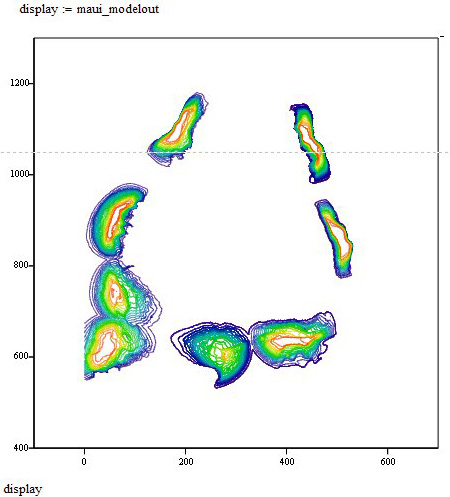 |

|
| Wessman Home | People | Projects | Contact |
| RESEARCH GROUPS @ CIRES > |
|
AMEF Project: |
PRIDE Project > Project Framework | Project Status | Modeling Approach | Project Milestones Niche Model for Algal Invasion in HawaiiA model-based mapping project of invasive marine species vulnerability in Hawaii is being conducted for the NOAA PRIDE program in the Pacific Region, as a collaborative pilot between NOAA and USGS/NBII's Pacific Basin Information Node. This project is to formalize a technique for approximating a niche hyper-volume in n-dimensions using modified Gaussian response curves that can be decomposed or combined to model various distributions. This stage of the project demonstrates the feasibility of applying this technique, and the potential for refining it and using it to address more complex questions, such as forecasting future invasion vulnerability. The next phase of the project, proposed for FY'06 will develop the architecture for building and applying such models in complex interactions and feedbacks that can underly simulations or just provide more detailed information about potentials.  The technique is based on producing a "potential distribution" or "suitability" using the n-dimensions of the niche as limits to distribution. In the simplest case that degenerates to a simple GIS overlay, but a more "ecological" combination of variables would be more typical. The fact that the technique is scalable between physical and ecological assumptions, and is expressed in one equation makes it easy to standardize within an informatics architecture. Decomposition of any response function into component modal forms (response functions) is an ambiguous transformation, meaning it can have many solutions (unlike Fourier analysis, for example), so part of this research is to establish what is meant by an "ecological" distribution as an ideal case and adopt that as the basic assumption. Combining the response functions and axes is a fundamentally complex problem requiring expert judgement and experience. Having some subjective input on the part of the modeler is actually a design principle here, to incorporate expert opinion in certain modeling decisions along the way rather than making it a typical black box.The approach can be operated on simple assumptions or can be opened to expert input and specifications. In this manner it can also aid in capturing indiginous knowledge about the conditions for certain ecological phenomena and distributions. Transparency is also good with this approach, allowing visualization of the actual niche hypervolume and individual response curves. Transparency may also help in communicating results to a skeptical audience. The idea is to make all the steps and decisions are transparent to the user and to help us understand what we're doing and to allow more opportunities for testing and improving models. The architecture will interface with a standard GIS and whatever enterprise systems are developed in PRIDE. It will become a built-in tool for defining and storing functional distributions along with all the “state-based" data we typically have in a GIS. |